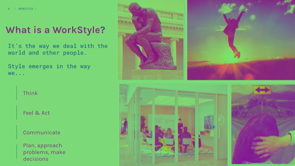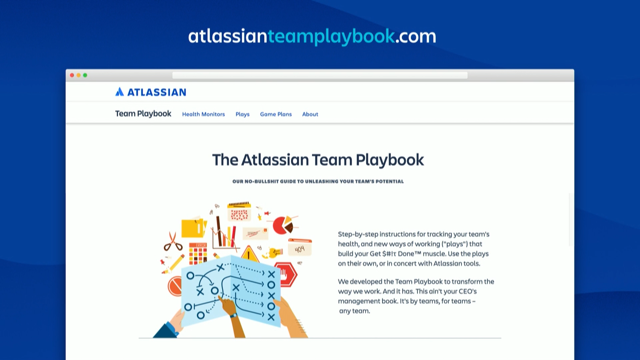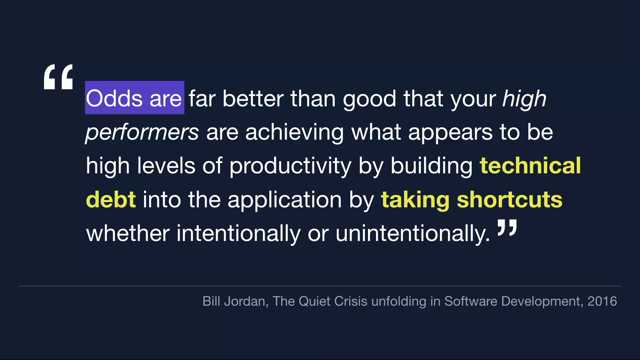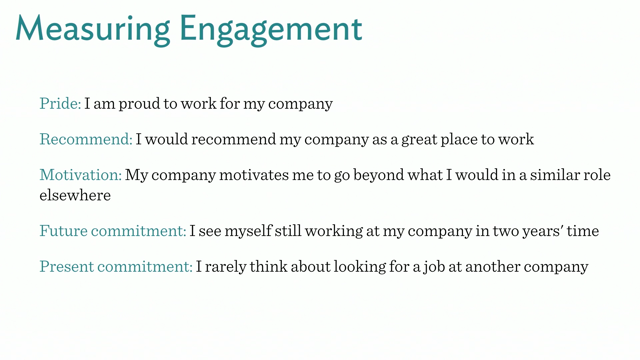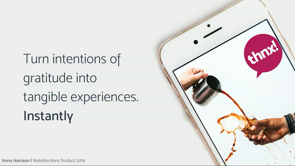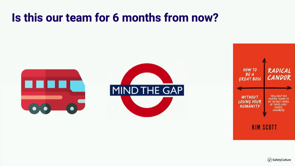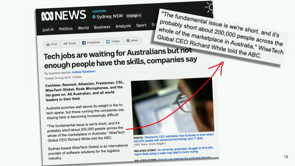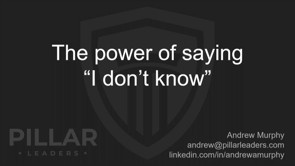
(vibrant electronic music) - I think all of you have been, have listened to three talks, have had the chance of listening to two.
Is it three so far? Four, great.
Good reason to, if you don't mind, please get up. Let's get some, the body flowing.
I'm not gonna ask you guys to do a dance or anything. So, if you just stretch your arms.
Just get a little bit a blood rushing in.
It's the first time I've ever done this.
So, it's great.
Okay, please, take a seat.
Look, I had the fortune of listening to our last two speakers.
And I think so much of, both the speakers alluded to how important it is to get the CEO's buy in or the executive team's buy in.
And a big part of my presentation is about how to think about culture, which is something that's quite abstract, something, a word which is quite abstract, like, love and, so forth to: How do we think about it in a much more commercial rational way so we can control it, manage it a lot better? So things I'd like to cover is: What, where and why, starting off with the organisation. What is culture? Crafting and controlling culture, the economics behind it. And numbers.
So, first off, just a quick intro.
I'm Mahesh, born in New Zealand.
Stats background, got into recruitment early on. Then did an MBA, got into strategy consulting. Then had my own tech startup, which was incredibly powerful.
Very valuable learning experience because learning how to build a product is very different to providing a service.
Then joined Canva, helped it scale for quite a few years. And then been part of the journey at Airtasker. Avid All Blacks fan, unfortunate All Blacks fan today. This is a picture of Batman, I like Batman. This is random picture, so, I'm gonna move on. So, look, a good place to start is, I think, is to acknowledge what is the primary, primary goal of an organisation.
And, in my opinion, the primary goal of an organisation is to create value.
What does value mean? Value, a very simple definition of value is if you have five logs of wood and you put it through this machine it becomes a table, right? There was some input, it went in and now it's more valuable, the output's more valuable than the input.
A bunch a people get together to create value. One person, five people, 10 people, 600, a thousand people.
So, there's a very strong argument to be made that every decision you make should be about creating value for the organisation. So, very quickly then it becomes: Wait, who is it for? Who is the value for? And as I go through the presentation these are just different ways, different frameworks to think through when you're thinking about culture and scaling culture. So, oh, apologies.
Give me one second, yes, right.
So, who is the recipient of value, right? At different stages, different organisations go through different priorities, right? At some point just perhaps just before an IPO or at a latter stage it might be the investors. At one stage the highest priority might be employees. At a different stage for a not for profit it might be government.
Is it society that is the most important? Is it end customer? I think it's really important and valuable for a CEO and an organisation and anybody that's quite senior designing what stage and where the organization's at to understand that there are a variety of different customer types for the organisation. And all of them are intention, right? What the investor actually, truly wants and what the employer truly wants, employee truly wants and what the customer truly wants are all different. The argument is that from a long term horizon perspective focusing on the customer's always best.
But it is important to understand that different people, different organisations at different stages have different priorities. I'm just gonna go back one.
Just a very high level in regards to the commercial argument for why focusing on culture and building a strong culture is: It helps you define a serious point of difference, it creates stakeholder value.
And I'll touch base on that again.
And it's a leading indicator of financial value. In regards to leading indicator of financial value I remember when I had a chance when I first started working with Tim at Airtasker and I really stressed on the point that, you know, we can look at financial results all we want and we can look at end results all we want. But that's, the project's done.
The work's done.
The exercise is done.
The initiative has been completed.
And then looking at the results doing a retro is incredibly valuable because you can reverse engineer and understand what actually worked, what didn't work.
What may be even more powerful is to look at the lead metrics, right? So, looking at: How are people feeling? How are people going? What is the attendance rate? Are people clear about goals, et cetera? Getting those metrics and getting context and understanding of that then allows you to set up the process, the mechanism that's about to go, the project, the team to focus on results.
So, giving your leadership team and your CEO control of, hey, actually maybe focusing on the lead metrics in regards to what's happening in the organisation would be really powerful as opposed to just looking at the lag metrics, which is usually revenue results and project results. What is it? It's a key point of difference for your company. So, I remember the first time I walked into Canva, it was 20 people and straightaway you, you felt there was a lot of design that was happening. It was very intentioned, where the tables were at, that there was a lot of space.
There was a dog going around.
It was very designed, right? So, straightaway an employee or anybody that came into contact with the company straightaway felt, oh, wow, this place is different. And in a war for talent, being very intentioned about how you set up your organisation.
I know Emma earlier talked, showcased how a place was set up to promote diversity and so forth.
Showing that then creates, again, results further down the road.
What is culture? It's a big word, it's a powerful word.
Just a little bit of a tangent.
I'm not a really big fan of the phrase: Culture fit. It's a powerful, culture's a powerful word. And when someone comes out of an interview and says that someone's not a culture fit it's very unlikely they've got an incredibly sophisticated understanding of what the organisational culture is and what this person's culture is and within, like, half an hour an hour they've made a sophisticated opinion on, yeah, you're not the right culture fit.
Incredibly complex thing to do.
I think if someone comes out of an interview and says: The person's not a culture fit, what they're saying is: I didn't like the person, which is absolutely fine, which is what they should say. I think it's far better to be, to think of onboarding someone into your culture. Check technical assessments, et cetera and then onboard a person into your culture just like a country should when it has new immigrants coming on board. But what does define culture? I started off by talking about what is the point of an organisation? A country is an organisation, right? And we have Indian culture, we have Australian culture, we have Chilean culture. What defines that? Why do they end up eating certain type of food? Why do hey end up sleeping at different points of the day? Why do they end up having different languages? Why do they end up using different words? In my opinion, at the base of it all is the geographical landscape, right? What are the crops, what kind of food do you eat? What is the weather like? So, the economic, that defines, then, the economic landscape.
How a person operates within that country, right? So, if a person was born in a different country they would talk and walk and act in a similar way. I had the opportunity of working in Mumbai for six months. And I just, just because of weather, like during the monsoon periods you just can't get to anywhere on time.
You just can't.
Infrastructure's really hard to set up.
So, you can see an argument to why in tropical hot weather environments why a relationship based culture makes more sense, right? But in a more temperate, cold weather environment where perhaps infrastructure's easier layout like the Nordics and European countries where a much more discreet data oriented culture works. I used to have friends, people working a project, people from a tropical environment and a temperate environment and the people from a temperate environment would turn up for the meeting on the dot.
And people from a tropical environment would come like five, six minutes late.
And then the guys who were on the dot they'd be like: You don't value my time.
And the people from a tropical environment go: Dude, just chill.
Like, we're friends, right? But understanding where you come from, what the economic landscape of your background is then helps you.
And then the leadership orientation of that organisation. Like the people who run the organisation that has a definition of culture.
Before I talk about Canva and Airtasker this is a slide provided by this guy called: Aswath Damodaran, he's the New York University Dean of Valuation, he's called: The Dean of Valuation.
He talks about how different organization's at different stages in their lives need to operate in different ways, right? So, a young fledgling startup has a high risk profile. And they need to operate in different ways. They need to hire different types of people. They need to have a different type of setup. While an organisation at its final stages, which is all about, hey, we gotta make as much money as we can.
We're done, we've gotta, the only way this business is growing is by letting ourselves die and investing into other high growth tech startups. That's the only way this business, it's a different business.
So, understanding what stage the organization's at, what industry you're in, forming an opinion on that then allows you to go: Okay, therefore the culture should be this way. We have these great place to work surveys and so forth, which is good.
It's good that we're measuring this stuff.
But you're not measuring like for like, right? And the only I think the categorization is zero to hundred, hundred to 500, et cetera.
But they're different types of organisations at different stages of growth, right, and different goals. We, as leaders and people and people operations in HR and also executive teams should be aware of what stage the organization's at.
So, opportunity to work at two different tech startups and helping them scale.
Just wanted to touch very quickly on how different it is even though they're two tech startups right? So, Canva's a SaaS platform.
So, you make a product, make a table, scale to a billion people.
As long as you get product market fit, let's go. Let's change it into different languages, change it to, go to different geographers.
You can keep growing.
Mail Chimp, a whole bunch of different products are like that.
Airtasker's an economy, a marketplace.
You're trying to create an economy.
There's two customer sides, it's different, it's incredibly complicated.
Obviously, Airtasker's significantly defendable as a marketplace 'cause it's hard to build a marketplace but a lot more complicated.
Understanding that for a SaaS based platform nailing the product first, getting engineering, product design right straight off the bat and then growing is the way to go.
While for a marketplace it actually has to be a sales and marketing oriented business first. You gotta get five people on one side, five on the other, hundred on one side, hundred on the other, a thousand, to build that critical mass, the liquidity within the marketplace.
And then to scale it it has to become a product engineering design company.
Because once you have that critical mass, if you look at the stories of Uber and Airbnb they would have gone through the same thing. So, again, understanding your business model where you're at, where business is at from an economic perspective then allows you to structure the right type of people operations and initiatives, et cetera.
And also allows you to have a frank conversation with the CEO around, hey, man, it's great we've been a sales and marketing organisation for the last three years now we have to shift and become this.
And I can show you the value of that, I can show you the examples.
So, again grasping being able to look at these things from these different frameworks gives you much more control. The outputs for culture are well known.
You have: Artefacts, shared values, shared assumptions. So, I'm not gonna stick to this too much.
I'm gonna zoom through a little bit faster if you don't mind 'cause there's just a bit more ground to cover. The way I think about employee experience is I think about employee experience like a product. This is from my days having had my own tech startup. The reason for this is you heard about the, before you downloaded Uber you heard about it, right? Someone told you about it.
Then you downloaded it.
Then you registered, then you accessed it.
Then you used it, then you used it again.
Then you referred it to someone.
You paid money at some point.
So, there was a whole life cycle that you went through. Now, this is not dissimilar to what an employee goes through.
That, you can see: Acquisition, activation, retention, revenue, referral.
In growth marketing circles that's referred to as pirate metrics because the first few letters reads out: AAR, that's literally, that's the reason why.
But it's the way I think about people operations and the employee experience.
You need to first acquire an employee, get them going, retain them.
At some point they start creating value.
And at some point they start referring people. Now, this is just one way of cutting it up. But looking at your employee experience and breaking it into discreet bits allows you then to measure the different parts. This is another way of breaking up the, perhaps a much more HR centric way of breaking the employee journey.
I'd like to move the conversation on to another a favourite topic of mine.
I've always been really curious about why, why things work and, so forth.
And I remember the first time, I didn't do economics in undergrad, so, and my MBA when I, the economics lecturer drew a supply/demand graph for the first time. And I went: Oh, so that's how everything works. Was this massive light bulb for me in regards to that's how the global economy works, how all of us work and how so many of our things are incentivized. So, I got really passionate about economics. And then I came across this branch in economics referred to as: Behavioural economics.
So, I'd like to touch on that a little bit. Classical economics assumes people are rational. And behavioural economics assumes people are irrational. Let me talk about that in a little bit more detail. So, like I said, classical economics assumes that if someone's told, someone's going on a diet or someone wants to get healthier and if a chocolate bar is put in front of them, their favourite desert is put in front of them that they will stick to their goals that they're oriented to.
And they will refuse the desert.
They will refuse another glass of wine because they've already set their goals, they're very clear, they're rational human beings. What we know, at least I know personally for myself is that I succumb and I'm quite irrational in these situations. So, most of our society is set up such that we're supposed to act like this.
But, in fact, most of the time we act like this, right? Human beings are incredibly rational.
We are incredibly bad at making judgements. We do not try to, at every single time we're not thinking: Hey, what is the total expected value of this decision? Let me understand what the pros and cons of these things are.
We are terrible at making assessments.
And what I'd like to touch on in the next few minutes is, perhaps the best thing we can do is acknowledge that we are terrible at it.
And working with leadership teams and CEOs, being able to get them to acknowledge that they're terrible decision makers just because human beings are.
I don't know if many of you can remember the scene from Men in Black.
Will Smith was asked to, was competing with a whole bunch of other soldiers or competitors and he shot the girl holding the quantum physics book as opposed to the monsters.
And how the scene goes is everybody else shoots all the monsters.
And he says: No, that person's exercising, that person's doing pushups, that person's having, that monster's having a walk.
This is the only one that stood out.
I thought it was a really good example of how, a really comical way of showing how he went against what may be deemed as: Oh, monsters are unsafe.
And little girls are safe.
What I'm trying to get to is that we have to make quick decisions all the time. And decision making can be broken down into Type 1 thinking and Type 2 thinking.
Type 1 thinking is flight or flight, a bear's running at me I've gotta make a decision. Type 2 thinking is slowing things down.
Thinking through decisions.
We have to make Type 1 decisions all the time. When a bear comes running at you you're not gonna go: Hey, let me just break out an Excel sheet and work out what do.
But the issue is we apply fight or flight Type 1 decision making in many Type 2 situations. When someone's about to get fired.
When performance management's happening.
An opinion's being formed on someone.
When there's a major people initiative that's going on. These are $100,000, $200,000 very expensive decisions. But we tend to, we are bad at making decisions. And then we rush them, too.
We don't tend to slow it down.
So, again, it is perfectly normal to want to use heuristics or things that we've known; I grew up this way, I was told that these group of people are bad or this sort of behavior's bad.
So, let me connect the dots and now I apply that into a brand new circumstance and therefore this is bad. That's how we operate.
But acknowledging that we're bad at making decisions and that we have this type of decision making allows us to go: Whoa, slow down.
One of the phrases that I try to impress into the organisation is: Think slow, act fast. Especially when you're dealing with people situations. Slow down, write a document, think it through. Just before I go onto this.
And I think I'm running short of time is I wanted to touch on biases.
And how we make decisions.
I do, and I'm gonna say something a little bit controversial so, I hope it's not too far-fetched.
I really struggle with the word, racist and, so forth. I think there's biassed behaviour perhaps racist behaviour. We all have biases.
We all use different heuristics to operate. And the heuristics or the biases that we operate to you can identify by looking in the mirror.
At some point I said, earlier on I said: I like Batman and I'm an All Blacks fan.
And during an interview or during conversation if someone was to bring either of those two things up I'd go: Oh, you're a nice person, right, because I know these things.
I'm familiar with these things.
But if someone was very unfamiliar to me, came from a different background then you would argue that I'm biassed against that person. Now, if I were to keep stretching that line of conversation, I'm a guy, I now guys, right, I know men.
I know what we go through.
I do not have a deep understanding of what women go through. I do not know what it's like for a woman to go on maternity leave.
I do not, I do not know the beginnings of what it feels like to go through all the stuff that women go through as a different group of people.
So, you could argue that as a guy I'm biassed against women, right? I think it's quite valuable to step up and go: Hey, this is my frame of reference and I don't want to operate.
I wanna operate in a fair frame of reference. So, then, the first thing I could do is to acknowledge my biases.
So that I can then work towards addressing them. I don't know if that was controversial.
But I encourage all of you to think through that and then allow ourselves to think through: What are my biases? And allow people next to you, especially senior leaders to go: This is what I know, this is what I don't know. Probably biassed towards this, biassed against this. If you can just get people to go there, then, perhaps it allows for better, more, stronger, better decision making.
Sorry.
Very quickly, oops, oops, oops, oops.
Last couple a things.
In regards to rationalising culture, I don't think we talk about numbers enough I don't know how many of you have worked out what the attrition rate in your organisation is, the actual dollar value of the attrition rate. Easy to work out.
It comes up to about $50,000/$60,000 per person. Multiply that through your organisation.
How many people have left, put that number on the table, you get the CEO's attention, right? And you go: Hey, that was about three, four million dollars. Do you wanna minimise that? Yeah, okay.
Can we invest more into designing better people initiatives. Yeah, sure, okay great.
And then there's a whole bunch a metrics there. A simple way of working out and this is not mine, this was provided by an organisation called: Lattice. But it's easy to work out.
You have different costs for: Learning, training, hiring, onboarding.
You make some assumptions, you add it all up. You add up the opportunity cost of projects that have been missed out because someone's left, things have slowed down. Put a probability down, It'll come up to about $50,000/$60,000.
From my experience that's roughly and you can make that number bigger with a little bit a creativity but you don't need to because it's still a big number.
And then use that number to make an argument to invest into people initiatives.
So, I zoomed through a few things.
I apologise, it was quite fast.
I talked about what an organisation is, what the point of an organisation is, why it should be in existence.
Tried to provide a framework for culture and how to think about culture and where it comes from, provided some sort of, introduced some sort of classical economics and behavioural economics and how we are irrational human beings and how we're set up to make really bad decisions and bad assessments.
Therefore, we need to acknowledge that and counter that. And also an argument for coming up with the commercial numbers.
Now, this is very rational.
I'd like to think what I've promoted is very rational. Please understand that when things happen it's a very irrational thing that occurs.
So, you need to recognise it.
Like, say there's an emergency, someone gets hurt. You may have the most rational exercise possible but if the market or your company looks at you going: I understand what you're trying to do but you hurt someone in trying to be rational. There's no point.
For example, I had a call the other day.
And someone made an argument for somebody else in the people space they were making an argument for making, a rational argument for making somebody on maternity leave redundant.
And they presented a very rational case for that. It was very logical.
But I was like, you can't do that, you can't. Like, you're not setting yourself up for success in regards to that.
So, acknowledging that we operate in a rational environment and the steps we need to take as rational as you may want to be, right, allows you to set decisions up for success. Cool, questions? (group clapping) (vibrant electronic music)
